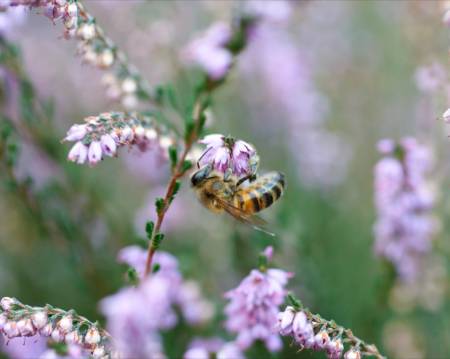The garden has an autumnal feel to it as meadow plants fade and set seed, and rose-hips are blackberries are ready for harvest. But it is now that heathland plants come into their own with the heather (or ling as it is sometimes called) and dwarf gorse in flower attracting a variety of bees including our own honey bees.
Heathland in flower with heather (Calluna vulgaris) and dwarf gorse (Ulex minor)
© Jonathan Jackson
Honey bee (Apis mellifera) on heather (Calluna vulgaris) this week
© Jonathan Jackson
Luke Dixon, our beekeeper, tells us what honey bees and beekeepers are up to at the moment:
"The bee season is coming to an end and the bees in the Wildlife Garden are preparing for winter. Honey bees are the only bee to survive through the winter as a colony. All other bees and wasps are dying off now and just the newly mated queens will live through the cold months. But the honey bees have been storing up honey so they have something to eat when the cold weather comes.
There is still plenty of activity at the entrance to the bee tree.
© Qais Zakaria
Inside our bee tree in the Wildlife Garden
© Qais Zakaria
The bees in our other hives have also made honey and we have harvested a little of it while leaving most for the bees for the winter.
Harvesting honey in the Wildlife Garden
© Derek Adams
It has the wonderfully complex taste of all urban honey. Town bees have much more to feed on than their country cousins and the honey they make contains all the flavours of the many different flowers that they can forage on, from the chestnuts and limes in the nearby royal parks, to the marjoram, dandelions, heather, holly and ivy nearer to home. Tasting the honey at the end of the season is one of the great rewards of beekeeping.
Honey-filled comb
© Qais Zakaria
We've had to close up the front of the hives to make the entrances as small as possible. Predatory wasps are a real problem this time of year and they been raiding the hives in search of bees and honey to eat. By reducing the hive entrances, the bees have a better chance of defending themselves. We've seen plenty of battles between wasp and bee around the hives.
As the weather gets colder the bees will form a cluster in the depths of the hive, keeping warm and protecting the queen. We'll leave them in peace until the warm weather returns and there is once again pollen and nectar to bring into the hives'.
Thank you Luke.
- The bee tree is laden with bees and with honey. You can check on them yourself with the webcam inside the hive.
- You can meet our beekeepers at our Hedgerow Harvest event on Sunday 5 October which falls close on the heels of Science Uncovered when you can visit us all to find out more about the Museum's work, and our work in the Wildlife Garden.
Taking advantage of late-flowering hemp agrimony (Eupatorium cannabinum) in flower in the Wildlife Garden fen
© Jonathan Jackson





-700px.jpg)